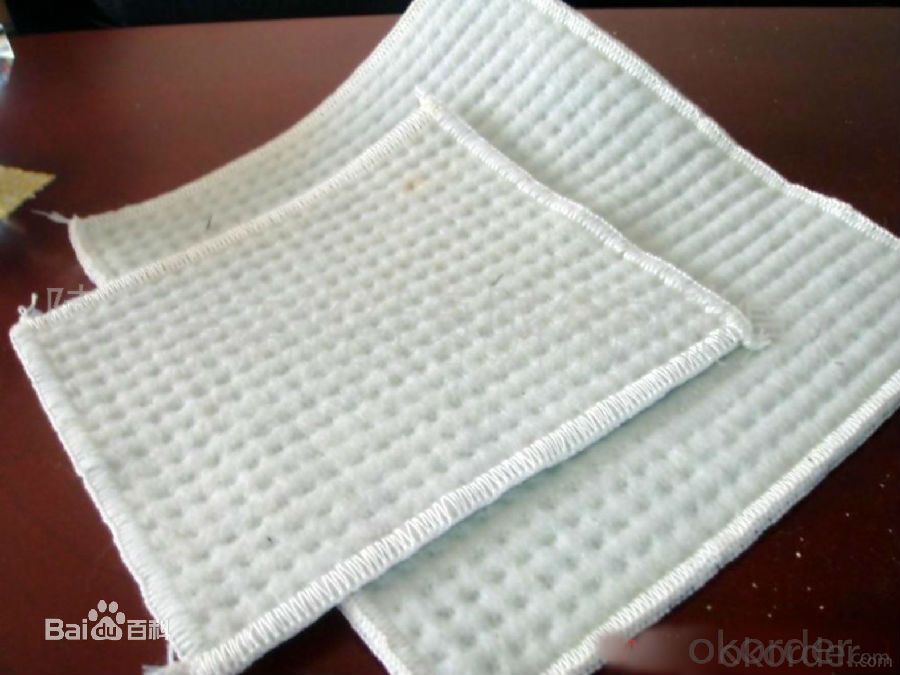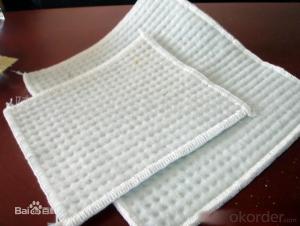High Swelling Bentonite Waterproof Blanket
- Loading Port:
- China main port
- Payment Terms:
- TT OR LC
- Min Order Qty:
- 3000 g/m²
- Supply Capability:
- 300000 g/m²/month
OKorder Service Pledge
OKorder Financial Service
You Might Also Like
1.Structure of Bentonite Waterproof Blanket Description:
Bentonite composite waterproof blanket (GCL) is a new type of geosynthetic materials. It is mixed by a natural grading sodium base bentonite particles and corresponding admixture. And by the special technology and equipment, it is fixed between the two layers of geotextile bentonite particles, made from bentonite waterproof blanket.It not only has all the characteristics of geotechnical material, but also has excellent waterproof performance (permeability).
2.Main Features of Bentonite Waterproof Blanket:
•Excellent waterproof performance.
•Having all properties of geotextile material, such as separation, reinforcement and protection, filter, etc.
•Easy for construction
•No affected by the limitation of the environment temperature, even under 0 ℃ can be construction too.
•The cost performance is relatively high.
•Being used in very wide range.
3.Bentonite Waterproof Blanket Specification:
| Expansion coefficient | ≥24mL/2g | |||
Fluid loss ≥ 24mL/2g | ≤18mL | |||
Tensile strength
| ≥400N | |||
| Peel strength | ≥65N | |||
Permeability | ≤5*10-9cm/sec |
4.Bentonite Waterproof Blanket Images:

- Q:Can a waterproofing membrane be used for train platforms?
- Yes, a waterproofing membrane can be used for train platforms. Waterproofing membranes are commonly used in construction to provide a protective barrier against water and moisture. By applying a waterproofing membrane to train platforms, it helps prevent water ingress, which can cause damage to the structure and pose safety risks.
- Q:Can a waterproofing membrane be used in elevator pits?
- Yes, a waterproofing membrane can be used in elevator pits. Elevator pits are vulnerable to water damage and moisture accumulation, so applying a waterproofing membrane can help prevent water intrusion and protect the elevator components from potential damage.
- Q:Is a waterproofing membrane resistant to abrasion?
- Yes, a waterproofing membrane is generally designed to be resistant to abrasion. The membrane is typically made of durable materials that can withstand friction and wear, ensuring long-lasting protection against water damage.
- Q:Are waterproofing membranes UV resistant?
- Indeed, the majority of waterproofing membranes boast UV resistance. Given their frequent exposure to sunlight, UV resistance is a crucial attribute for these membranes. Over time, the degradation and deterioration caused by UV rays can significantly impair the effectiveness and durability of materials, necessitating the inclusion of UV-resistant additives or coatings by manufacturers. This incorporation of UV resistance safeguards the integrity and performance of the membrane, guaranteeing enduring protection against water infiltration.
- Q:What are the proper installation techniques for a waterproofing membrane?
- Proper installation techniques for a waterproofing membrane involve a series of steps to ensure effective and long-lasting protection against water infiltration. 1. Surface preparation: It is crucial to start with a clean and smooth substrate. Remove any loose debris, dirt, or previous coatings. Repair any cracks or imperfections in the surface before proceeding. 2. Primer application: Apply a suitable primer to enhance adhesion between the substrate and the waterproofing membrane. The primer should be compatible with both the substrate material and the membrane. 3. Membrane selection: Choose a waterproofing membrane that is appropriate for the specific application and site conditions. There are various types of membranes available, including sheet membranes, liquid-applied membranes, and self-adhesive membranes. Consider factors such as the substrate material, expected movement or stress, and exposure to chemicals or UV radiation. 4. Membrane installation: The exact installation method may vary depending on the type of membrane used, but the following general steps apply to most installations: a. Unroll or unfold the membrane carefully, avoiding any wrinkles or folds. b. Position the membrane onto the primed surface, ensuring it extends beyond the desired waterproofed area. c. Use a roller or trowel to firmly press the membrane onto the substrate, ensuring good contact and removing any air pockets. d. Overlap the edges of adjacent membrane sheets or sections according to the manufacturer's instructions, typically around 2-3 inches. e. Apply a suitable seam or joint adhesive to seal the overlaps securely. 5. Testing and inspection: After installation, it is essential to perform a comprehensive quality control check. Conduct a flood or water test to ensure the membrane effectively repels water and there are no leaks or defects. 6. Protection and finishing: Protect the installed membrane from damage during construction activities, and apply any necessary protection layers or coatings to enhance its durability and resistance to UV radiation or mechanical stress. 7. Maintenance and repair: Regularly inspect the waterproofing membrane and promptly address any signs of damage, wear, or deterioration. Follow the manufacturer's guidelines for maintenance and perform necessary repairs as soon as possible to maintain the membrane's effectiveness. Remember, it is always advisable to consult with a professional waterproofing contractor or follow manufacturer recommendations for the specific membrane being used, as installation techniques can vary.
- Q:Can a waterproofing membrane be used on roofs with flat surfaces?
- Roofs with flat surfaces can indeed benefit from the application of a waterproofing membrane. In fact, it is quite common to use these membranes on flat roofs to safeguard against water infiltration. The primary function of these membranes is to establish a barrier that obstructs water from seeping into the roof structure and causing harm. Typically, they are constructed using materials like modified bitumen, EPDM, or PVC, which exhibit great resistance to both water and UV rays. To install the membrane, it can be done by torch-application, adhesive adherence, or mechanical fastening. To ensure optimal effectiveness and longevity of the waterproofing membrane on a flat roof, it is crucial to guarantee proper installation and regular maintenance.
- Q:Can a waterproofing membrane be used for a parking garage deck protection?
- Indeed, the utilization of a waterproofing membrane is a viable option for safeguarding the parking garage deck. Designed with the specific purpose of preventing water infiltration and shielding the underlying structure from moisture-related harm, a waterproofing membrane proves to be highly effective in such scenarios. When applied to the parking garage deck, the waterproofing membrane acts as a barrier, effectively preventing water from permeating the concrete and reaching the steel reinforcement beneath. This, in turn, mitigates the risk of corrosion and deterioration, ultimately prolonging the lifespan of the structure and minimizing the need for expensive repairs or replacements. Moreover, the waterproofing membrane offers protection against other potential sources of damage, including oil or chemical spills resulting from vehicular activity. By creating a barrier, it successfully hinders these substances from penetrating the concrete and causing unsightly stains or deterioration. Supplementary to its protective capabilities, the waterproofing membrane enhances the overall durability and strength of the parking garage deck. It aids in the reduction of cracking, spalling, and other forms of concrete damage that may arise due to freeze-thaw cycles, temperature fluctuations, or heavy loads. All in all, opting for a waterproofing membrane to safeguard the parking garage deck is a highly recommended solution for ensuring the longevity and structural integrity of the facility. By providing a dependable defense against water infiltration, chemical spills, and other potential sources of damage, it serves to decrease maintenance expenses and extend the lifespan of the parking garage deck.
- Q:Are waterproofing membranes resistant to earthquake-induced water pressure?
- Waterproofing membranes can provide some level of resistance to earthquake-induced water pressure, but their effectiveness may vary depending on the specific membrane and the magnitude of the earthquake. Waterproofing membranes are designed to create a barrier against water infiltration, protecting the structure from water damage. However, they are not specifically designed to withstand the pressure caused by earthquakes. During an earthquake, the ground can experience significant shaking and movement, which can result in increased water pressure in the surrounding soil and groundwater. This increased pressure can potentially cause water to seep through the waterproofing membrane, compromising its effectiveness. To enhance the resistance of waterproofing membranes to earthquake-induced water pressure, additional measures may be required. These can include reinforcing the membrane with materials that can absorb shock and movement, installing drainage systems to alleviate excessive water pressure, and ensuring proper installation and maintenance of the membrane. It is important to consult with a professional waterproofing expert or structural engineer to determine the most suitable waterproofing system for earthquake-prone areas. They can provide guidance on selecting membranes that are specifically designed to withstand higher water pressure and offer better protection against earthquakes.
- Q:Can a waterproofing membrane be used on modified bitumen roofs?
- A waterproofing membrane is capable of being utilized on modified bitumen roofs. In fact, it is quite customary to apply a waterproofing membrane on top of modified bitumen roofs in order to provide an extra layer of defense against water infiltration. This is particularly crucial in regions where heavy rainfall occurs or where the roof is frequently exposed to water. The waterproofing membrane serves to seal any potential cracks or openings in the modified bitumen roofing system, thereby preventing water from penetrating and causing damage to the underlying structure. Moreover, the waterproofing membrane can also bolster the overall durability and longevity of the roof by shielding it from the detrimental effects of moisture.
- Q:Are waterproofing membranes fire-resistant?
- Waterproofing membranes can vary in their fire-resistant properties. Some waterproofing membranes are specifically designed to be fire-resistant, while others may not have any fire resistance at all. It is important to check the specifications and certifications of the specific waterproofing membrane in question to determine its fire-resistant capabilities. Additionally, building codes and regulations may also dictate the required fire resistance of waterproofing membranes in certain applications.
1. Manufacturer Overview |
|
|---|---|
| Location | |
| Year Established | |
| Annual Output Value | |
| Main Markets | |
| Company Certifications | |
2. Manufacturer Certificates |
|
|---|---|
| a) Certification Name | |
| Range | |
| Reference | |
| Validity Period | |
3. Manufacturer Capability |
|
|---|---|
| a)Trade Capacity | |
| Nearest Port | |
| Export Percentage | |
| No.of Employees in Trade Department | |
| Language Spoken: | |
| b)Factory Information | |
| Factory Size: | |
| No. of Production Lines | |
| Contract Manufacturing | |
| Product Price Range | |
Send your message to us
High Swelling Bentonite Waterproof Blanket
- Loading Port:
- China main port
- Payment Terms:
- TT OR LC
- Min Order Qty:
- 3000 g/m²
- Supply Capability:
- 300000 g/m²/month
OKorder Service Pledge
OKorder Financial Service
Similar products
New products
Hot products
Related keywords



























